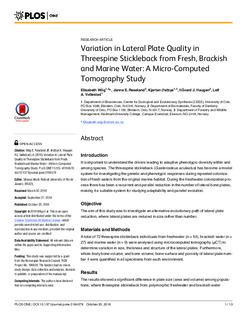Variation in Lateral Plate Quality in Threespine Stickleback from Fresh, Brackish and Marine Water: A Micro-Computed Tomography Study
Original version
Wiig E, Reseland JE, Ø stbye K, Haugen HJ, V ø llestad LA (2016) Variatio n in Lateral Plate Quality in Threespine Stickleback from Fresh, Brackish and Marine Water: A Micro-Comput ed Tomograp hy Study. PLoS ONE 11(10): e0164578. doi:10.137 1/journal.pone .0164578 10.137 1/journal.pone .0164578Abstract
Introduction
It is important to understand the drivers leading to adaptive phenotypic diversity within and among species. The threespine stickleback (Gasterosteus aculeatus) has become a model system for investigating the genetic and phenotypic responses during repeated colonization of fresh waters from the original marine habitat. During the freshwater colonization process there has been a recurrent and parallel reduction in the number of lateral bone plates, making it a suitable system for studying adaptability and parallel evolution.
Objective
The aim of this study was to investigate an alternative evolutionary path of lateral plate reduction, where lateral plates are reduced in size rather than number.
Materials and Methods
A total of 72 threespine stickleback individuals from freshwater (n = 54), brackish water (n = 27) and marine water (n = 9) were analysed using microcomputed tomography (μCT) to determine variation in size, thickness and structure of the lateral plates. Furthermore, whole-body bone volume, and bone volume, bone surface and porosity of lateral plate number 4 were quantified in all specimens from each environment.
Results
The results showed a significant difference in plate size (area and volume) among populations, where threespine stickleback from polymorphic freshwater and brackish water populations displayed lateral plates reduced in size (area and volume) compared to marine stickleback
Conclusions
Reduction of lateral plates in threespine stickleback in fresh and brackish water occurs by both plate loss and reduction in plate size (area and volume).
